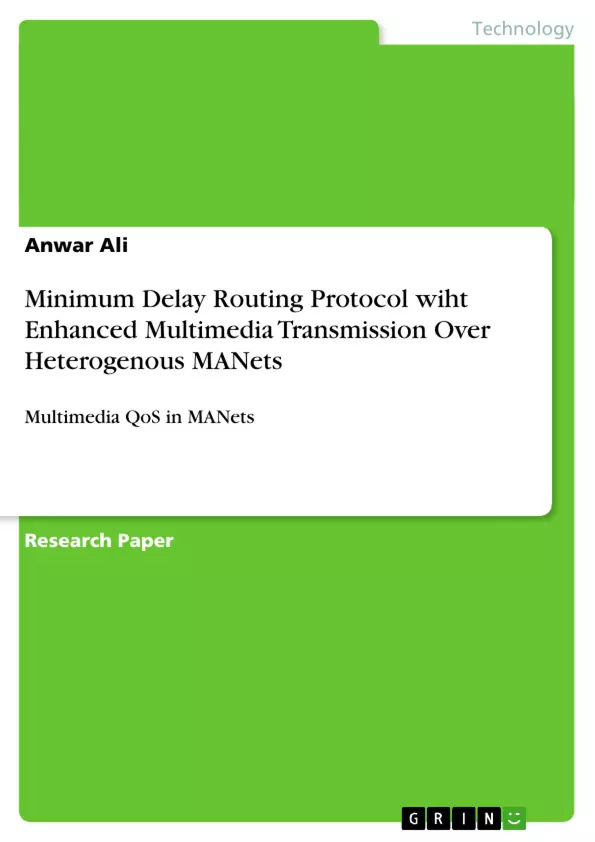Mobile Ad-hoc network popularly known as MANETs, consists of mobile nodes without any fixed infra-structure, where each node actively participates in routing a multi-rate network employs nodes with different data rates, radio range and bandwidth. A heterogeneous MANET has various kinds of mobile nodes. Thus to deliver message from source to destination or to have per-to-peer communication it not only requires a route establishment but also to ensure minimum delay.
we attempt to analyze various delays involving in packet transmission with mathematical formulation and conditions subjected to certain assumption .This mathematical modeling proves to be sufficient to answer the QoS demands like finding the path with minimum delay among the available paths from source to destination, taking into consideration the route parameters like geographic distance and data rate. Another application is the packetizing (or) packet/cell framing to utilize other paths whose data rates may be degraded, this increase the utility and efficiency of overall network. Minimum delay routing protocol (MDRP) can also be used to determine the routes having same delay though they may differ in terms of geographical distances and data rates. Such approach will efficient in multimedia transmission over parallel links with minimum delay jitters. Various critical situations have been solved using proposed techniques as examples to validate the protocol.
Inhaltsverzeichnis (Table of Contents)
- I. INTRODUCTION
- II. RELATED WORK
- III. PROPOSED APPROACH
- A. Impact of Delay on Transmission
- B. Mathematical Modelling of Delay
- C. Algorithm for minimum delay routing protocol(MDRP)
- III. DEMONSTRATION MODELS
- A. Model 1 (Minimum delay routing)
- B. Model 2 (Enhanced Multimedia Transmission)
- IV. CONCLUSIONS
Zielsetzung und Themenschwerpunkte (Objectives and Key Themes)
This research focuses on enhancing multimedia transmission over heterogeneous mobile ad-hoc networks (MANETs) by minimizing delay. The paper proposes a Minimum Delay Routing Protocol (MDRP) to address the unique challenges of heterogeneous MANETs, where nodes possess varying data rates, radio ranges, and bandwidth. The objectives include identifying the route with minimum delay, analyzing delays involved in packet transmission, and optimizing the network for multimedia communication.
- Delay minimization in heterogeneous MANETs
- Multimedia transmission over parallel links
- Impact of network parameters on delay
- Efficient packet framing and routing algorithms
- Application of the proposed protocol to critical topologies
Zusammenfassung der Kapitel (Chapter Summaries)
- Introduction: The paper introduces the concept of heterogeneous MANETs and their unique characteristics, highlighting the importance of minimizing delay for efficient communication, especially for multimedia transmission.
- Related Work: This section discusses existing approaches to delay minimization in MANETs, including Genetic Algorithm-based methods, improved versions of AODV, and QoS-based routing protocols. It identifies limitations in these existing methods and highlights the need for a more comprehensive approach that considers various delay components and network parameters.
- Proposed Approach: The paper proposes a Minimum Delay Routing Protocol (MDRP) based on mathematical modeling of end-to-end delay. This section delves into the impact of delay on transmission, including processing delay, queuing delay, transmission delay, and propagation delay. It then presents a mathematical formulation of delay, considering the influence of various network parameters.
- Demonstration Models: Two critical topologies of heterogeneous MANETs are used to demonstrate the effectiveness of MDRP. The first model focuses on minimum delay path estimation, while the second model explores the application of MDRP for enhanced multimedia transmission over parallel links.
Schlüsselwörter (Keywords)
This research centers around the key concepts of multi-rate MANETs, bandwidth, delay minimization, and multimedia transmission. The focus is on optimizing network performance through a combination of delay analysis, route optimization, and efficient packet framing. This includes understanding the various components of delay (processing, queuing, transmission, and propagation delay), as well as the impact of network parameters such as geographic distance, data rate, and packet size. The proposed MDRP aims to improve multimedia transmission by minimizing delay jitters and optimizing resource allocation, enhancing the efficiency of heterogeneous MANETs.
- Quote paper
- Anwar Ali (Author), 2012, Minimum Delay Routing Protocol wiht Enhanced Multimedia Transmission Over Heterogenous MANets, Munich, GRIN Verlag, https://www.grin.com/document/210095



